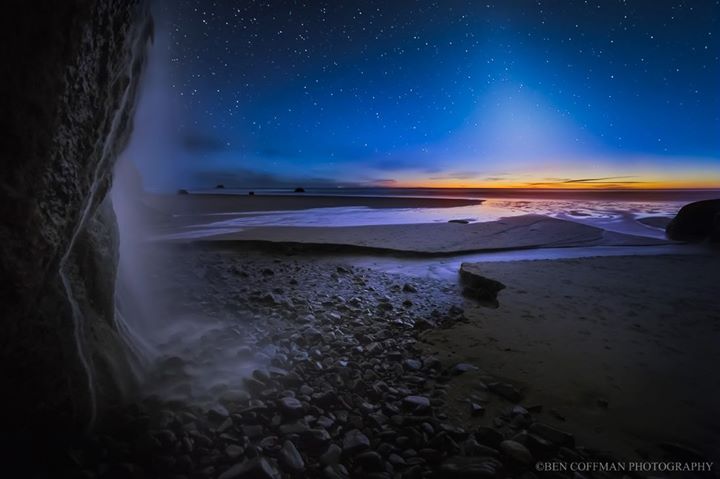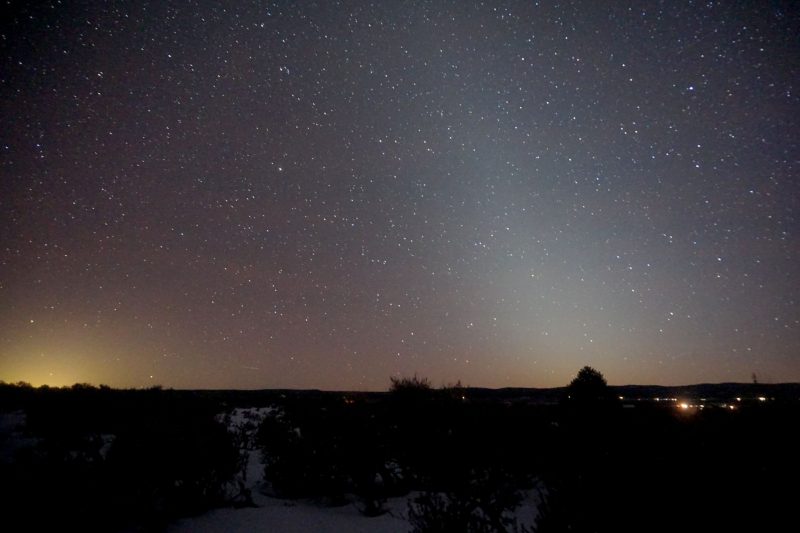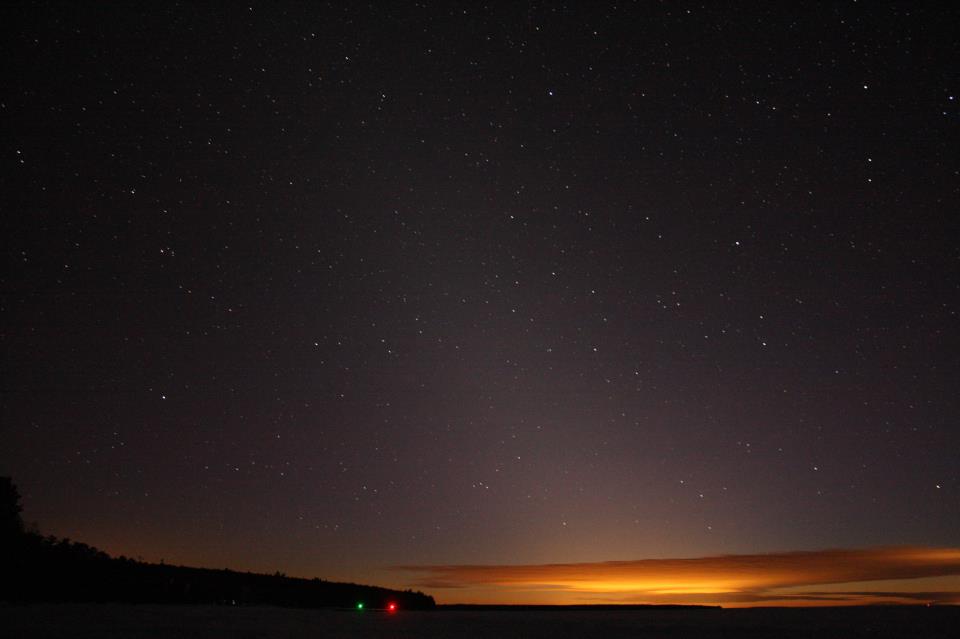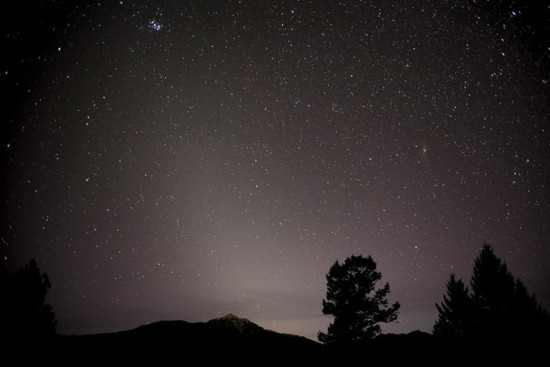

Image via EarthSky friend Ben Coffman.
The zodiacal light is a cone of eerie light at the sunrise or sunset point on the horizon, before dawn breaks or after twilight ends. No matter where you are on Earth, you’ve got the best chance of seeing it in the west in late winter or early spring (false dusk). Your best chance to see it in the east before dawn is late summer or early autumn (false dawn).
Maybe you’ve seen the zodiacal light in the sky and not realized it. Maybe you glimpsed it while driving on a highway or country road at this time of year. Suppose you’re driving toward the west in springtime the hour after dusk. You catch sight of what you think is the lingering evening twilight, or the light of a nearby town, just over the horizon. Instead, you may be seeing the zodiacal light.
In late winter and early spring, it looks like a hazy pyramid of light extending up from the western horizon, after evening twilight ends.

View larger at EarthSky Community Photos. | Our friend Mike Lewinski in Tres Piedras, New Mexico, caught the zodiacal light on an evening in late January 2019. He wrote: “I noticed it with the unaided eye.” Thank you, Mike!

Photo via Robert Snache.
Springtime? Autumn? Is there a difference between Earth’s two hemispheres? Yes and no. For both hemispheres, springtime is the best time to see the zodiacal light in the evening. Autumn is the best time to see it before dawn. Look for the zodiacal light in the east around the time of the autumn equinox. Look for it in the west after sunset around the time of the spring equinox.
But, of course, spring and autumn fall in different months for Earth’s Northern and Southern Hemispheres. So if you’re in the Northern Hemisphere look for the zodiacal light before dawn from about late August through early November. In those same months, if you’re in the Southern Hemisphere, look for the light in the evening.
Likewise, if you’re in the Northern Hemisphere, look for the evening zodiacal light from late February through early May. During those months, from the Southern Hemisphere, look for the light in the morning.

Zodiacal Light over the Faulkes Telescope, Haleakala, Maui. Photo via Wikimedia Commons.
What is zodiacal light? People used to think zodiacal light originated somehow from phenomena in Earth’s upper atmosphere, but today we understand it as sunlight reflecting off dust grains that circle the sun in the inner solar system. These grains are thought to be left over from the process that created our Earth and the other planets of our solar system 4.5 billion years ago.
These dust grains in space spread out from the sun in the same flat disc of space inhabited by Mercury, Venus, Earth, Mars and the other planets in our sun’s family. This flat space around the sun – the plane of our solar system – translates on our sky to a narrow pathway called the ecliptic. This is the same pathway traveled by the sun and moon as they journey across our sky.
The pathway of the sun and moon was called the zodiac or pathway of animals by our ancestors, in honor of the constellations seen beyond it.
The word zodiacal stems from the word zodiac.
In other words, the zodiacal light is a solar system phenomenon. The grains of dust that create it are like tiny worlds – ranging from meter-sized to micron-sized – densest around the immediate vicinity of the sun and extending outward beyond the orbit of Mars. Sunlight shines on these grains of dust to create the light we see.
Since they lie in the flat sheet of space around the sun, we could, in theory, see them as a band of dust across our entire sky, marking the same path that the sun follows during the day. And, it’s true, there are sky phenomena associated with this band of dust, such as the gegenschein. But seeing such elusive sky phenomena as the gegenschein is difficult. Most of us see only the more obvious part of this dust band – the zodiacal light – in either spring or fall.

View larger. | The zodiacal light is easier to see as you get closer to Earth’s equator. But it can be glimpsed from northerly latitudes, too. Here’s the zodiacal light seen by EarthSky Facebook friend Jim Peacock on the evening of February 5, 2013, over Lake Superior in northern Wisconsin. Thank you, Jim!

Here’s the zodiacal light as captured on film in Canada. This wonderful capture is from Robert Ede in Invermere, British Columbia.
How I can see the zodiacal light? The zodiacal light can be extremely bright and easy to see from latitudes like those in the southern U.S.
Meanwhile, skywatchers in the northern U.S. or Canada sometimes say, wistfully, that they’ve never seen it.
You’ll need a dark sky location to see the zodiacal light, someplace where city lights aren’t obscuring the natural lights in the sky. The zodiacal light is even milkier in appearance than the summer Milky Way. It’s most visible after dusk in spring because, as seen from the Northern Hemisphere, the ecliptic – or path of the sun and moon – stands nearly straight up in autumn with respect to the western horizon after dusk. Likewise, the zodiacal light is easiest to see before dawn in autumn, because then the ecliptic is most perpendicular to the eastern horizon in the morning.
In spring, the zodiacal light can be seen for up to an hour after dusk ends. Or, in autumn, it can be seen for up to an hour before dawn. Unlike true dusk, though, there’s no rosy color to the zodiacal light. The reddish skies at dawn and dusk are caused by Earth’s atmosphere, while the zodiacal light originates far outside our atmosphere, as explained above.
Look for the zodiacal light in the west after sunset in late winter and early spring, around the time of the spring equinox. Look for it in the east before sunrise in late summer and early autumn, around the time of the autumn equinox. The darker your sky, the better your chances of seeing it. Your best bet is to pick a night when the moon is out of the sky, although it’s definitely possible, and very lovely, to see a slim crescent moon in the midst of this strange milky pyramid of light.
If you see it, let us know!
Bottom line: The zodiacal light is a hazy pyramid of light extending up from the western horizon, beginning about an hour after sunset in springtime.
Enjoying EarthSky? Sign up for our free daily newsletter today!
Source:
https://earthsky.org/astronomy-essentials/everything-you-need-to-know-zodiacal-light-or-false-dusk